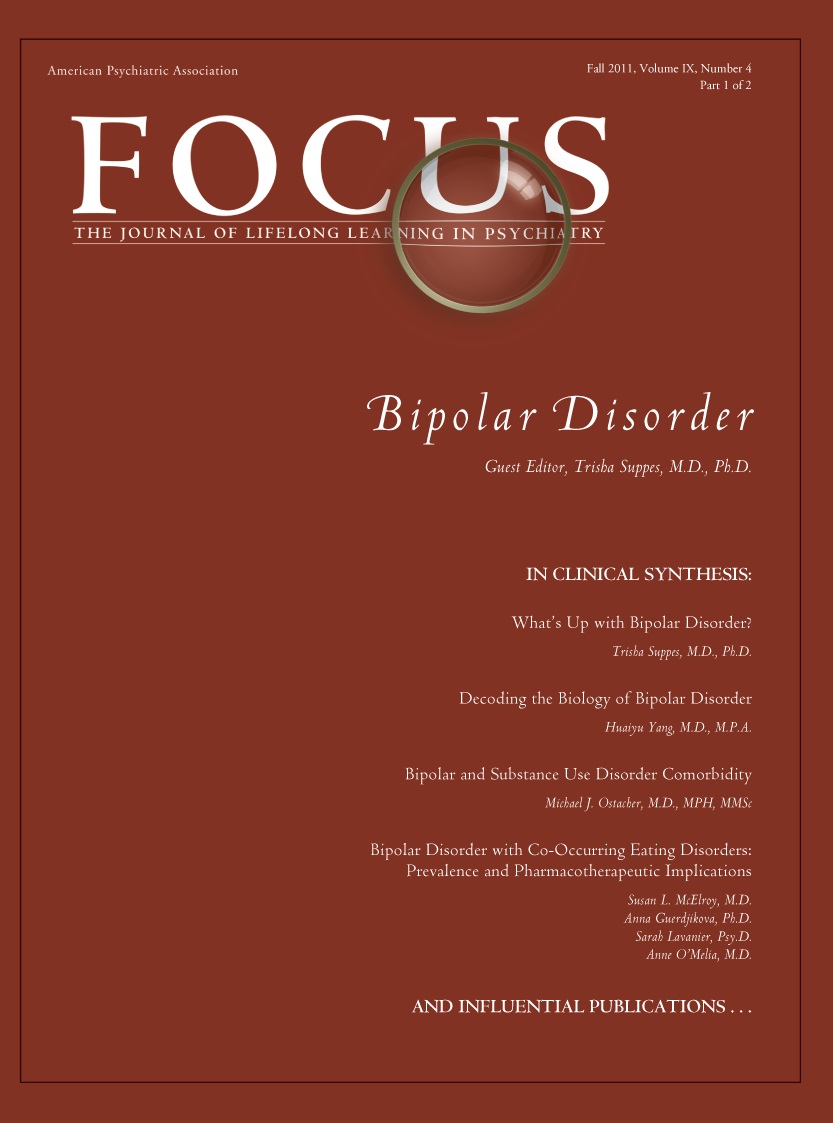Ask the Expert: Bipolar Disorder
In meetings and presentations, I am increasingly hearing the term “mixed depression”—what is it and how best should I be treating it?
There is no consensus or operationalized criteria for mixed depression. There are however, several definitions that generally define the concept as a syndromal episode of major depression plus several symptoms (i.e., nonsyndromal) of mania/hypomania (1–4). Review, for example, the following case report.
A 30-year-old businesswoman sought consultation for persistent depressive symptoms and increased irritability despite ongoing antidepressant (venlafaxine 300 mg) and mood stabilization (divalproex sodium 1000 mg) cotherapy. She had been treated with divalproex since her first and only admission 10 years ago for nonpsychotic mixed mania complicated by alcohol abuse and migraine. Her current symptoms include depressed mood, anhedonia, guilty ruminations, early morning awakening with reduced appetite, and weight loss. In addition, she reports irritability, racing thoughts, distractibility, and an uncomfortable energy that she describes as “pushed, hyperactive, wired and tired.” All these symptoms were present despite a therapeutic level of valproate (60 mcg/dl). The addition of venlafaxine has reduced the symptom severity of depression and anhedonia by 50% but the irritability, racing thoughts, and agitation have increased.
This presentation (i.e., episode of major depression with concurrent minimal hypomanic symptoms and a history of mania) is consistent with mixed depression. It is increasingly recognized that mixed depression is not uncommon as more than 50% of depressed patients with bipolar disorder followed in the Systematic Treatment Enhancement Program for Bipolar Disorder (STEP-BD) program study reported subsyndromal symptoms of mania/hypomania; most commonly, the symptoms were distractibility, racing thought/flight of ideas, increased activity, and increased speech (5).
This distinction between mixed depression and traditional or DSM-IV-TR mixed mania [major depression plus three manic (euphoric)/or four (mixed) symptoms)] or mixed hypomania (6) is unclear. It is unlikely that one symptom would distinguish distinct categorical disease states. More likely is a spectrum of mixed presentations with original Kraepelinian descriptions (i.e., depressive or anxious mania, excited depression, and depression with flight of ideas) that remain timelessly rich (7). It is clear that DSM-5 is focusing on this categorical versus dimensional aspect of mixed presentations in mood disorder (8). The proposed revision is to have a “mixed features specifier,” which would apply “in episodes where subthreshold symptoms from the opposing pole are present during a full mood episode”; these symptoms may be “relatively simultaneous,” or “they may also occur closely juxtaposed in time as a waxing and waning of individual symptoms of the opposite pole.”
What remains is how best to treat mixed depression. There are few data other than studies that show, in comparison to nonmixed depression, reduced response to antidepressant therapy and antidepressant-induced mania (9, 10). A recent 6-week randomized, double-blind, placebo-controlled study, which reported efficacy of ziprasidone in mixed depression (n = 44 bipolar II and 30 major depressive disorder), is the first study to look at mood stabilization therapy (11). Further study for diagnostic clarification in bipolar and unipolar disorders as well as treatment guidelines is warranted.
1. Benazzi F: Bipolar disorder—focus on bipolar II disorder and mixed depression. Lancet 2007; 369:935–945Crossref, Google Scholar
2. Bauer MS, Simon GE, Ludman E, Unutzer J: ‘Bipolarity’ in bipolar disorder: distribution of manic and depressive symptoms in a treated population. Br J Psychiatry 2005; 187:87–88Crossref, Google Scholar
3. Koukopoulos A, Albert MJ, Sani G, Koukopoulos AE, Girardi P: Mixed depressive states: nosologic and therapeutic issues. Int Rev Psychiatry 2005; 17:21–37Crossref, Google Scholar
4. Maj M, Pirozzi R, Magliano L, Bartoli L: Agitated depression in bipolar I disorder: prevalence, phenomenology, and outcome. Am J Psychiatry 2003; 160:2134–2140Crossref, Google Scholar
5. Goldberg JF, Perlis RH, Ghaemi SN, Calabrese JR, Bowden CL, Wisniewski S, Miklowitz DJ, Sachs GS, Thase ME: Adjunctive antidepressant use and symptomatic recovery among bipolar depressed patients with concomitant manic symptoms: findings from the STEP-BD. Am J Psychiatry 2007; 164:1348–1355Crossref, Google Scholar
6. Suppes T, Mintz J, McElroy SL, Altshuler LL, Kupka RW, Frye MA, Keck PE Jr., Nolen WA, Leverich GS, Grunze H, Rush AJ, Post RM: Mixed hypomania in 908 patients with bipolar disorder evaluated prospectively in the Stanley Foundation Bipolar Treatment Network: a sex-specific phenomenon. Arch Gen Psychiatry 2005; 62:1089–1096Crossref, Google Scholar
7. Kraepelin E: Manic-Depressive Insanity and Paranoia. Classics in Psychiatry. Salem, NH, Ayer Company, Publishers, Inc., 1921Google Scholar
8. DSM-5 revision. www.dsm5.org/ProposedRevisions/pages/proposedrevision.aspx?rid=483Google Scholar
9. Frye MA, Helleman G, McElroy SL, Altshuler LL, Black DO, Keck PE Jr, Nolen WA, Kupka R, Leverich GS, Grunze H, Mintz J, Post RM, Suppes T: Correlates of treatment-emergent mania associated with antidepressant treatment in bipolar depression. Am J Psychiatry 2009; 166:164–172Crossref, Google Scholar
10. Frye MA, Hellemann G, Suppes T, McElroy SL, Grunze H, Altshuler LL, Keck PE, Kupka R, Nolen W, Leverich G, Post RM: Prevalence rate of mixed depression and its impact on remission: a controlled evaluation.
11. Patkar A, Gilmer W, Pae C, Filkowski MM, Holtzman NS, Vöhringer P, Whitham EA, Thommi SB, Loebel A, Masand P, Ghaemi NS: A 6 week randomized double-blind placebo-controlled trial of ziprasidone for the acute depressive mixed state. PLoS (in press).Google Scholar



